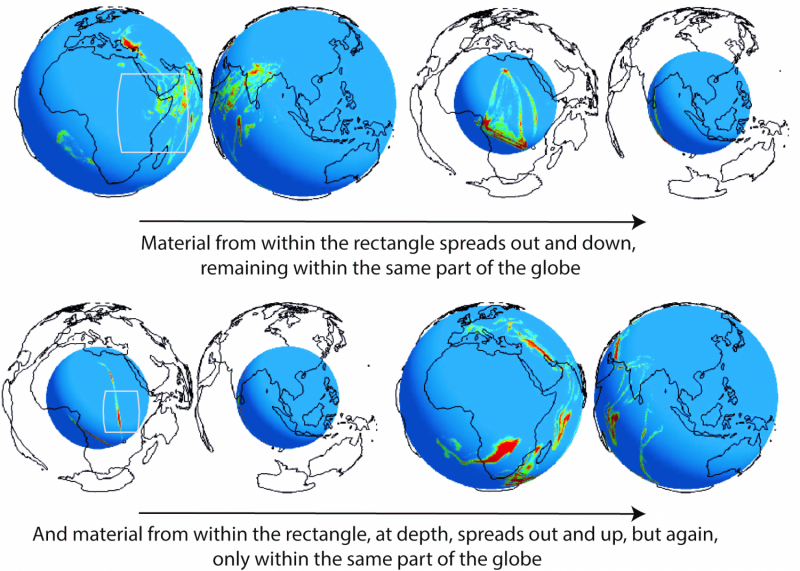Whole-mantle convection with tectonic plates preserves long-term global patterns of upper mantle geochemistry

New insights into the convection patterns of the Earth's mantle and its chemical makeup have been revealed by a researcher from the University of Leicester.
The new findings suggest that the mantle does not flow ubiquitously, as has been previously thought – and that it is instead divided into two very large domains that convect only within themselves, with little evidence of them mixing together.
The research, led by Dr Tiffany Barry from the University of Leicester, Department of Geology, and published in the journal Scientific Reports, suggests that one of these domains is found under the Pacific Ocean while the other exists outside of it.
The research suggests that upper mantle material flows to lower parts of the mantle when it reaches a subduction zone, where one tectonic plate descends beneath another one.
This descending slab of material acts as a sort of curtain, preventing upper mantle material mixing all the way around the globe and keeping the two domains separate.
Dr Barry explained: "One of the ways our planet is unique is in the amazing way it has mobile plates at the surface that move and jostle about over time. This movement of the plates results in the process we call plate tectonics, and no other planet we know shows evidence of this process. Why or how plate tectonics started on this planet is not understood, but it has been utterly essential in the production of the crust and oceans that we recognise as Earth today. What is also not well constrained is what effect plate tectonics has on the internal workings of the Earth.
"We have found that when mantle material reaches the bottom of the mantle, at the outer core, it does not spread out and go anywhere around the core, but instead returns to the same hemisphere of the globe from where it came. We have modelled this dominantly up-down motion of convection and found that it can persist for 100's millions of years.
"On the basis of past plate motions and geochemical evidence, we speculate that this process of mantle convection could have been a dominant process since at least 550 million years ago, and potentially since the start of plate tectonics."
The researchers combined spherical numerical computer models (3-D finite element modelling) with the best available reconstructions of how Earth's plates have moved over the past 200 million years to track mathematical particles placed at different depths of the modelled mantle.
With these models they examined where the mantle freely moves to during the history of plates moving around at the surface. Having tracked where particles flow in the models, the team then examined chemical isotope evidence from past ocean basins, which are a good analogy for the composition of the upper mantle in the past.
With this data they were able to test whether former ocean basins, that are no longer present, had the same or different composition to subsequent basins that formed geographically in the same region of the globe.
Dr Barry added: "I'm incredibly excited by this work; it has been a research question I've been pondering for nearly two decades. It feels like a real privilege to have been able to piece together a robust and convincing model that can explain the feature of the chemical differences in ocean floor crust.
"This new research overturns our understanding of how the inside of the earth convects and stirs, and how it is divided up, and for the first time explains observations that were first noted in the late 1980s."
More information: T. L. Barry et al. Whole-mantle convection with tectonic plates preserves long-term global patterns of upper mantle geochemistry, Scientific Reports (2017). DOI: 10.1038/s41598-017-01816-y
Journal information: Scientific Reports
Provided by University of Leicester



















